The Best Carnival in the World
The New York Times recently nominated Rio de Janeiro as the best place in the world. The best place for what? Well, apparently they didn’t specify. So far as we yotties are concerned it isn’t the best, by any means – it isn’t even the best place in Brazil – but it does have a certain something special. And, of course, it does have the world’s most famous and extravagant carnival. It so happened that Mollymawk was anchored little more than a cannon shot from the city when the festival suddenly loomed up ahead of us, and thus we were half inclined to think that perhaps we ought to consider the idea of maybe going along to check it out… Since the rest of us couldn’t quite muster the enthusiasm our skipper went roving along, all alone, to the party. When he got back he dutifully and enthusiastically wrote a report – and here it is: Nick’s very first contribution to the website!
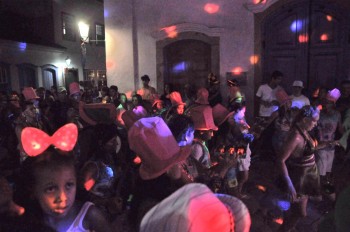
Carnival in Brazil consists of lots of people having a four day street party, with lots of music and lots of drinking. Actually it’s a four night street party. The days are pretty quiet. The action takes place five hours either side of 2am. Most towns have a stage set up for a string of bands and shows. Samba is what it’s all about, and any local band will happily play samba until they are told to make way for the next band; and the crowd will dance samba until daylight. The next carnival thing is the blocos. A bloco consists of a float which produces very loud live music and proceeds slowly down the street with an entourage of singing, dancing, fancy-dressed bloco members following behind. As the bloco progresses the crowd falls in behind, until the street is full of happy people slowly following the source of the music. Blocos take many forms – they usually have some theme or message to justify their existence and to give some focus on how to dress up the float and the participants. Anything from global warming to the local secondary school, or a good restaurant, or an Evangelical church will do. With luck there will be some sponsorship involved to pay for it all.
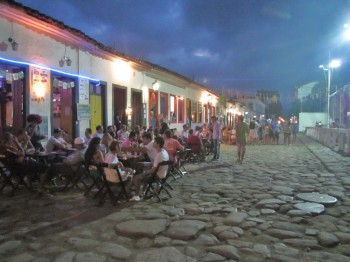
Mollymawk was in Paraty (on the Ilha Grande bay) – every Brazilian’s favourite holiday resort. Between Christmas and Carnival is holiday time in all Brazil, and Paraty responds hard, with thousands of people taking boat trips every day, and expensive restaurants and souvenirs everywhere. It seemed like a good place to spend carnival – and so it turned out. There were crowds of people, lots of whom were tourists – but mainly Brazilian ones; few other foreigners – and there were endless beer vendors with eskies (cooler boxes) balanced on bicycles, tricycles, shoulders, traffic bollards, etc. A new bloco set off every two hours between 9pm and 3am. And the stage in the main square had some form of very loud music all night.
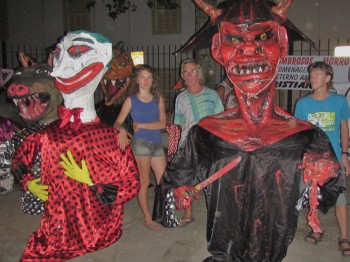
But the on first night – Friday – we went ashore just as it was getting dark, at 7pm. Nothing much was happening this early, but gradually a crowd started appearing. The first event on the stage was at 9pm – carnival songs and a sing-along. The only bloco we found was a group of fishermen with a beach buggy full of speakers and a few microphones and guitars. Another parade of weird pantomime animals and grotesque characters went past. Jill got some pictures. “Boring,” said Caesar. So before midnight we went back to the boat. “We were too early”, we decided. “Next time we’ll go ashore at midnight.” Then I had another idea. Rio was only 70 miles away. ‘A meior festa do mundo,‘ said the newspapers – The biggest party in the world. ‘O mais grande espectaculo da tierra’ – The greatest show on Earth. Better go and see… So, this was the proposition – Take the bus at 5am on Sunday to arrive at 11am; party all day and night; catch the first bus back on Monday morning (4am) and be back aboard by midday. Roxanne giggled. Jill was not into it either, despite the prospect of taking lots of photographs. Caesar said, “Sounds boring”… So that just left me.
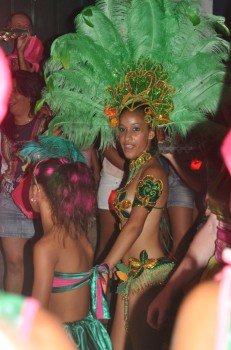
That evening, Roxanne, our friend Gean and I went ashore around midnight. Paraty was heaving. Various blocos had attracted large crowds. The stage was being very loud. The beer can collectors were working at the same speed as the vendors (very fast), and a good time was being had by all – including us. We got back to the boat at 3am, which gave me a hour to make sandwiches, fill a water bottle, sew a secret pocket into my shorts (to confound the Rio pickpockets), and get ashore again to catch my bus. Paraty was still going at full pelt when the bus to Rio left at 5am, and the next thing I remember is waking up at 10am in the bus station on the outskirts of the famous city of Rio de Janiero.
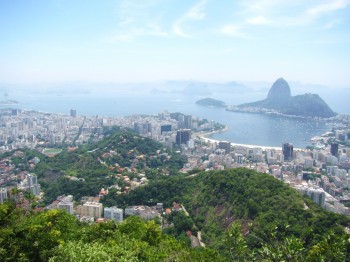
Apart from size, the big difference between carnival in Rio and carnival elsewhere in Brazil is the Samba Schools. These ‘schools’ are dotted all over the city’s centre and suburbs. Many are steeped in tradition and history and are sponsored by companies and wealthy individuals. They also receive donations from members of the public. The local government (and, probably, the national government) also put in some money. Their objective is to be the Samba School which provides the finest carnival procession of the year. These processions get bigger every year, and one big Samba School can produce a show half a mile long, with 5,000 participants – including famous film stars and celebrities – and ten or more floats. The top schools are said to each spend £10,000,000 on their efforts, every year! (Yes, ten MILLION pounds!) This side of carnival is big business, and it’s not on show for free. The processions are assembled outside a special auditorium, called the sambódromo, and they immediately pass inside its walls. Once inside, they are very carefully judged on every tiny aspect of their extremely complicated shows. The prizes are big – and so are the ticket prices. Tickets for one night start at £70 and go up to about £300 for a good place near the middle front. Anyway, more of this later – although it had already occurred to me that standing outside, and watching the processions enter into the sambódromo, would probably be quite good enough for me. So – I went to the information centre in the bus station and I asked, “What’s going on for carnival today? Any blocos or stage shows?” I was given a ‘Street Carnival Timetable’ listing 128 blocos for that day… “Get down to Ipanema,” said the woman. “That’s where the action is this morning.” So I jumped on a city bus and headed south to the beaches. The bus passed several crowds following baterias – groups of 50 or so drummers, drumming very loudly while pushing their way through the masses; all to the samba rhythm, of course. Lots of roads were closed, so I wrote down the name of each as a potential place to check out, later.

Ipanema was very busy. They reckoned there were half a million people on the beach by 10am and probably a million by midday. (The first bloco had been at 7am; about the same time as the last one from the previous day…) And then there were the beaches of Leblon and Copacabana, too. In total, about four miles of beach, with a belt of sand fifty yards wide, and fifty yards of road and pavement behind that – and all with standing room only. If you just picked up a guitar or a drum, about 5,000 people would come over to have a look. And every five yards or so there was a vendor with an ice box, doing very good business and being topped up by boys on delivery bikes, who were bringing more ice and beer from trucks parked a few blocks away. There was good music and entertainment as the blocos, each with up to 150,000 followers, went by. During the procession of ‘Afro-reggae’ – a long standing and respected bloco, and a big favourite – the police tried to clear up some of the illegal vendors and ended up with a mountain of drinks, bicycles, sign posts, bells, hats… For me the main entertainment was the crowd: so many people, most of them quite young, just being happy to be there and to be part of the fun. Despite some pretty hard drinking – partly because it was so hot; in the top 30s, and with little shade – I never saw a fight. In fact, I never even heard one raised voice all day and night.
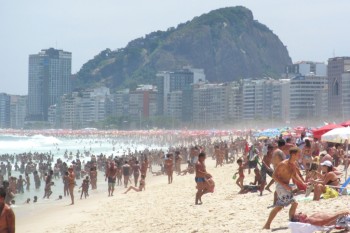
I didn’t really want to spend all day on the beach – I was keen to get back to town – but I knew there was an information centre half way along Copacabana, so I decided to walk there – about two miles from where I was – and then go to town from there. The visit to the info centre brought a good result, as I was given a very useful glossy book which explained everything that was happening. But the advice from the people on duty was, “Stay down here.” They told me that the best shows that evening would be on the Copacabana. “You can’t see anything of the Samba Schools from outside the sambódromo,” they added. “You have to be inside.” I caught the bus back to the city, anyway. There was a big gig going on in a park in the district of Gloria (where the Marina Gloria is to be found), and I nearly got off there; but I decided to stay on for another two miles, to the end of the route, and then walk back. At the end of the route, at the top of Avenida Presidente Vargas, I found the sambódromo, with loads of carnival floats parked up in the street outside, waiting for action later. The sambódromo is about half a mile long, and it’s built especially for the carnival weekend, closing off that particular road. I’d noticed, already, that the banks and shops in Avenida Presidente Vargas (which is the main street in the city) were all boarded up. The banks had notices on the ATM machines saying “Come back on Wednesday”! The Samba starts at 9pm, I was told – so I made a mental note to come back later and I wandered back towards the park. The way back took me through Rio Branco – a long wide street, despite it’s name… – and these two streets, Vargas and Branco were where I was to spend the rest of the day and night. But first to the park, where there was a huge gig going on, with Sargento Pimento, a Beatles look-alike and sound-alike band playing from a mocked-up London bus. The music had a slight samba influence, as was necessary for the occasion.. and they had a great dance troupe. They were pretty good. But I don’t suppose they normally get 100,000 spectators, as was reported later in the papers! It was simply that there were so many people around, and all looking for some fun.
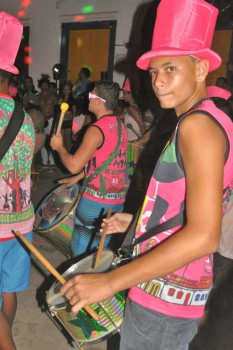
At about 6pm I wandered back to Rio Branco, which was now really busy. There were baterias everywhere, being as loud as they could, and the occasional bloco with themes ranging from the Lei Seca (a surprisingly popular, very strict, new drink/driving law) through to Evangelist preachers. The latter were accompanied by swarms of pretty young girls with clip boards who were trying to convert the masses, one by one. Sometime before 9pm I walked back up Vargas towards the sambódromo. There were people everywhere, and all drinking beers and various vodka and lemonade type mixes, and all throwing the empty cans down about as fast as the ‘recyclers’ could pick them up. You can get £1 a kilo for empty aluminium cans, and although there is no government organised recycling in Brazil many people derive the greater part of their income from this source. As a result, 87% of cans are recycled (as compared to under 50% in the USA). During carnival you can use an empty can of Antarctica beer as a metro ticket. However, this is not so much to promote recycling and discourage littering as to keep the drinkers off the road (and persuade them to buy Antarctica, of course).

When I arrived back at the sambódromo the troupes were getting themselves ready. The floats were lighting up and the people were putting on their carnival costumes. I took up station across the road, outside the sambódromo entrance, with a few hundred others. Sunday and Monday are devoted to the ‘Special Section’, which consists of famous Samba Schools who have won the carnival probably many times in the past. The first one tonight was Sao Clemente, whose theme was soap operas of the past. Each float represented some specific soap opera and was followed by hundreds of dancers, extravagantly dressed and made up to be relevant TV characters. They had two famous actresses, one leading the show in the commisao de frente, and another further back. They also had a famous and much publicised Italian choreographer to organise the dancing. The best bit was watching the huge floats trying to get under a road bridge which stands just fifty yards outside the sambódromo entrance. Some of the floats had folding or removable bits that had to be very quickly reassembled after the bridge. It’s all very high drama, and show, and extravagance to the uninitiated, such as myself, but to the Cariocas (as the people of Rio are known) and to anyone else who really understands what it is all about, everything has a reason. The procession is judged on numerous very fixed details, from the size, design, and colours of the floats, to the costumes, the dancing, and the timing of everything. Each school writes a Samba song and this is judged on its content – including wit, relevance, and so forth – and on its rhymes, and even on the troupe’s ability to sing it in the allotted time. Since it doesn’t take long to travel the length of the sambódromo this is rather short, and so the sambas these days are sung very fast! The next procession was Mangueira. Their theme was Cuiaba, which is the capital of Mata Grosso – ‘um paraiso‘ (a paradise). I gathered that Mangueira were one of this year’s favourites and that they are one of the longest standing and most successful Samba Schools. Their procession seemed to me to be rather similar to the first one… and so I got back on with the street party.

Back on the Rio Branco there was even more noise and people than before. I came upon a stage for the velha guarda (literally, the old guard) – the samba singers of the past, singing their previously well known hit songs. This was very popular with everyone of all ages, including youngsters. The oldest singer was 93 and she had to be more or less carried on and off the stage and occasionally reminded of which songs she had sung already. This didn’t stop her from giving us a flash of her fish-net stockings – to roars of approval from the crowd! By four in the morning I’d had nearly enough carnival for one day, but as the bus station is quite near to the sambódromo I stopped at my favourite spot and watched one more Samba School entering the arena. A good discovery I made was that just down the road there were groups of bars showing the inside of the sambódromo on huge TV screens. So, having seen the real thing disappear into the tunnel, you could then watch it arriving inside, on the telly. You also got an explanation of it all and interviews with the actresses, etc. The TV’s interest in the Samba Schools was diluted by the distraction of a VIP area, in which celebrities from all over the world had been paid, by the hour, to make appearances wearing the T-shirt of some brewery or other. I was tired. I got the 6am bus home.
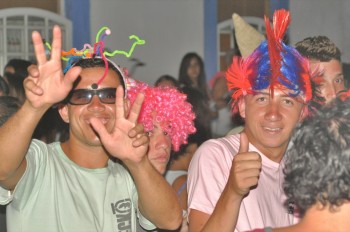
Back at Paraty there was still the last day of carnival to deal with: Mardi Gras, or Shrove Tuesday as we know it in England. So we had pancakes and then, at midnight we went ashore. A man in a side street was entertaining hundreds with a flea circus. A good band on stage was followed by a less good one. There was a teenage bloco making lots of noise, and a scantily clad 13 year old future Carnival Queen smiled prettily and samb-ed along the road. Everyone was determinedly having fun, as usual, in the way that only Brazilians know how. We met a Swiss couple, from another yacht, who were on a month’s holiday in Brazil. They had been to Rio and then Paraty. “It’s more fun here,” they said. “Rio’s too big; too many people.” I know what they meant, but I don’t quite agree. I like the crowds!
